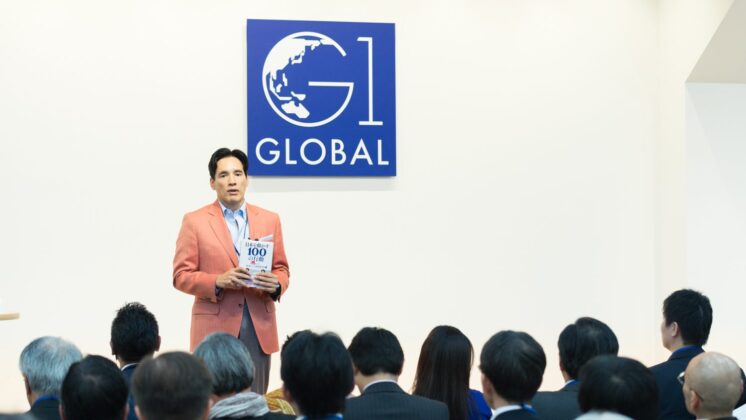The 100 Actions project was started in July 2011 to create a vision for Japan while generating national policy debate. Four years later, with the completion of a draft constitution in July 2015, I finally finished inscribing 100 Actions.
Let me take this opportunity to briefly explain the background of 100 Actions. It began when I went, in my 20s, to the United States to study at Harvard Business School. The period encompassing my school days in Japan and my 20s was the heyday of Japan’s bubble economy, during which we often heard the phrase “Japan is No. 1.”
From the high economic growth period to the bubble economy period, by focusing on capital-intensive industries, such as steel, automobiles, and home appliances, Japan was beating the world. In these segments, Japan beat the United States and Europe, leading the world. In subsequent years, however, South Korea and China began to catch up. Meanwhile, the United States in the early 1990s was transitioning to a knowledge-intensive economy. Following established companies such as Microsoft and Apple came Google, Amazon, Facebook, and Tesla, which collectively served as a driving force of the country’s economy.
Seeing this, I felt that the Japanese industrial structure would also have to change. Still in my Harvard days, I put pen to paper and drew a diagram consisting of three circles. This was the beginning of GLOBIS. The three circles represented People, which means a graduate school of management; Capital to create new industries; and Knowledge to support them. I intended to create and provide these three elements to support a knowledge-intensive economy. Just as we can produce any color, I reasoned, by mixing the three primary colors of red, yellow and blue, we can create and transform any company by combining People, Capital, and Knowledge, three primary elements of management. Based on this notion, I drew the three circles to encapsulate my vision, which would become GLOBIS.
This was the precise moment when the vision of GLOBIS as an organization to “foster management ecosystems of People, Capital, and Knowledge to bring creative change and innovation to society” was born. I went to the United States to study at Harvard Business School in the midst of the Japan-bashing and returned to Japan after the bubble economy collapsed, at which time I focused my efforts on establishing GLOBIS. I launched GLOBIS all by myself, based out of a room in an apartment in Sangenjaya and a rental classroom in Dogenzaka in Shibuya in Tokyo. My business school startup later grew into a graduate school of management, with five campuses in Tokyo, Osaka, Nagoya, Sendai, and Fukuoka. The Graduate School of Management issues an MBA both in Japanese and English and provides an online learning environment. Its scale is now by far the largest in Japan, and the school is consistently placed in the top three in the Nikkei Shimbun’s business school ranking.
In terms of Capital, the venture capital business now has 50 billion yen in total funds. GLOBIS has been involved in launching new businesses, such as Works Applications, GREE, SmartNews, and Mercari. In terms of Knowledge, the GLOBIS MBA book series has sold more than 1.5 million copies, and the GLOBIS mobile app is widely used.
GLOBIS has continued to grow without pause. In contrast, Japan, over the same period, has continued its decline. At the World Economic Forum meetings in Davos, Switzerland, where leading figures gather from around the world, I’ve noticed Japan’s presence becoming smaller and smaller. Its once strong image was no longer apparent in that particular arena, which left me appalled. As a result, I began to think seriously about what I could do, as a Japanese person, to address this situation. This thinking eventually led to the launch of the G1 Summit.
The G1 Summit was born in February 2009 at Aizu-bandai. I organized it because I thought that Japan needed a platform where leaders from different sectors could gather, talk, learn and act under the concept of “making a better Japan.”
The first G1 Summit was attended by 107 participants. Dr. Shinya Yamanaka, who gave the keynote speech, was later awarded the Nobel Prize. Another attendee, Mr. Seiji Maehara, went on to assume the office of Minister. Mr. Hiroshige Seko, meanwhile, has been playing a key role as Deputy Chief Cabinet Secretary since the inauguration of the second Abe Cabinet. And Mr. Shinzo Abe himself, who participated in the third G1 Summit, became Prime Minister.
The G1 Summit has been held at a different place each year. In 2013, the G1 Institute was established, and its activities expanded to include the G1 Summit (its main focus) as well as the G1 Global Conference, G1 Executive, G1 U-40 (G1 Next-Generation Leaders’ Summit), G1 Venture, G1 Region, and G1 College. These seven conferences are held annually.
One of the mottos of G1 refers to the “responsibility of a generation.” I believe that rather than putting it off, it is the responsibility of our generation to address various issues, such as the declining birthrate and the fiscal reform as well as issues related to energy, education and reconstruction, and to pass on our efforts to the next generation. To fulfill this responsibility, I think there is no other way but for like-minded leaders to get together in order to share and implement their visions.
To improve and reform Japan, we must offer a specific future direction. This should not be one told to us by others, but instead be based on our own research and thinking, organized systematically and put into words. Specific actions to be taken based on such a vision must be presented, and the actions must function as a checklist. The 100 Actions lays out the direction in which we should head to make Japan better.
Why 100? Any troubled company can recover if it does ten things that it should do. In this country, which is pervaded by a sense of stagnation, I thought that if we could fully implement 100 needed actions, there would be a bright future. Based on this notion, I chose the word “action,” a strong word with a positive sense, over “proposal,” a weak one.
The 100 Actions are divided according to areas of concern of ministries and agencies. A draft was developed in such a way as to clarify where responsibilities lie. The 100 Actions were completed through a process of ongoing discussion and revision involving members of the G1 Policy Research Institute.
Our efforts have been made not to avoid or sidestep the issues, but rather to face and address them head on, even the taboo issues that cannot be addressed by politicians. We have taken on this task as our generational responsibility. Among G1 members, of course, the individual issues have their pros and cons. However, the strong determination not to fear or avoid heated discussions or taboo topics in order to offer a direction for reform for the sake of the next generation is shared among all the G1 members.
As of May 2016, I get the feeling that Japan is changing, little by little. Like-minded people participating in G1 have come to play central roles in both the governing and non-governing political parties over the last seven years, substantially influencing Japanese politics. G1 members who are private citizens also play important roles on governmental advisory panels and within economic organizations.
Meanwhile, in local governments, leaders are promoting reform and, in economic settings, numerous ventures are exerting an impact on society through their business. The 100 Actions are being implemented in practical settings.
I strongly encourage those who have chosen the 100 Actions to actively use them as a reference to change the present-day Japan. Specific actions are clearly described, along with actual cases and data. I also provide one table or figure for each theme to help you deepen your understanding.
This website lists the 100 Actions. As social circumstances are constantly changing, some items on the website may have already been implemented by the government or other concerned parties. In such cases, use this website as a checklist.
Above all, I will be most pleased if you choose to join this “silent revolution” by observing society using this website as your standard, by thinking independently, and by joining us to make Japan better.
A “Silent Revolution” Initiated by 100 Actions
The 100 Actions is a project to delineate Japan’s future visions through 100 actions, while promoting national policy debates. Companies can turn themselves around if they can execute ten necessary actions. Japan’s prospect may look bleak, but a brighter future will open up for us if we can carry out the 100 necessary actions.
The 100 Actions Project is intended to develop visions and specific actions for the future of Japan. The silent revolution will be over with the successful completion of the 100 actions. We are working together to make Japan’s future brighter and full of hope for the next generation.
Yoshito Hori
President, G1 Institute



